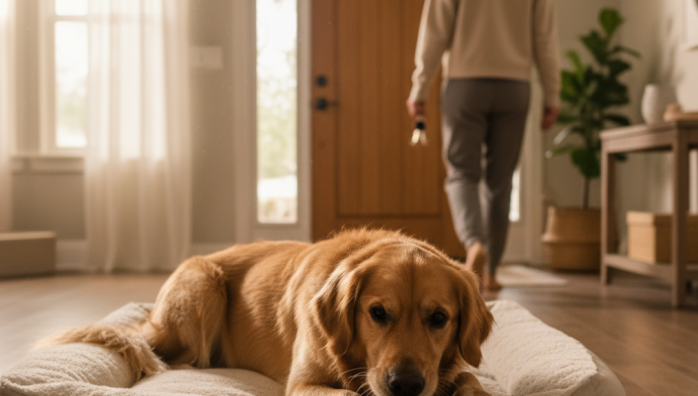Pre-Departure Routine to Calm Anxious Dogs
by admin in Pet Care Basics 19 - Last Update November 16, 2025

When I first transitioned to a hybrid work schedule after months of being fully remote, I didn\'t think much about how it would affect my dog, Charlie. I was so wrong. The first few times I left, I came back to a whirlwind of anxious energy and a chewed-up welcome mat. It was clear my constant presence had become his new normal, and my departures were a source of major stress. The guilt was immense. I realized that my long, emotional goodbyes, filled with \'I\'ll miss you so much!\' and frantic petting, were only fueling his anxiety.
Why a consistent routine is a game-changer
Dogs thrive on predictability. For an anxious dog, the unknown is terrifying. A pre-departure routine acts like a roadmap, calmly signaling to your dog what\'s about to happen and, most importantly, that it\'s okay. It’s not about sneaking out; it\'s about building their confidence that your leaving isn\'t a scary, random event. It took some trial and error, but creating a low-key, predictable sequence of events was the single most effective thing I did to ease Charlie\'s separation anxiety.
My step-by-step pre-departure routine
This is the exact routine I honed over several weeks. The key for me was to keep everything calm and matter-of-fact. I shifted my mindset from \'abandoning my dog\' to \'just running an errand\'.
Step 1: The wind-down (30 minutes before leaving)
I used to think a high-energy game of fetch would tire him out, but I learned it just got him amped up and made the subsequent crash of me leaving even worse. Now, the 30 minutes before I go are dedicated to calm. We might do some gentle cuddling on the sofa, or I\'ll give him a simple puzzle toy to work on. The goal is to lower the energy in the house, not raise it.
Step 2: The positive association (15 minutes before leaving)
This is where I prepare his \'alone time\' reward. For Charlie, it’s a frozen KONG toy stuffed with some of his favorite treats. He only gets this specific, high-value toy when I\'m leaving. He sees me preparing it and his focus immediately shifts from my imminent departure to the delicious treat he\'s about to get. It’s a powerful tool for creating a positive association with my absence.
Step 3: The subtle cues (5 minutes before leaving)
I calmly gather my things – my bag, my coat, my keys. I learned not to jingle my keys frantically, as that was a huge trigger. I just pick them up and put them in my pocket. I do all of this without giving him direct, sustained eye contact or talking to him. I\'m not ignoring him, just acting \'boring\' and purposeful.
Step 4: The non-event goodbye (at the door)
This was the hardest change for me to make, but the most crucial. I no longer have a big farewell. I give him his KONG, and as he’s getting started, I walk to the door and say a simple, upbeat \'Be back soon!\' and then I leave. No more long hugs, no sad tones. It\'s a non-event. The first time I did this, I felt awful, but when I checked the pet cam later, he was calmly working on his toy instead of pacing at the door.
What to avoid during your routine
Through my own mistakes, I learned there are a few definite \'don\'ts\' when it comes to anxious dogs:
- Dramatic goodbyes or hellos: Keeping departures and arrivals low-key helps regulate their emotional state.
- Punishing anxious behavior: Yelling at a dog for chewing something out of anxiety will only increase their stress.
- Inconsistency: The routine only works if you do it consistently every time you leave, whether it\'s for 20 minutes or 4 hours.
This routine was a game-changer for us, but remember every dog is an individual. For severe cases of separation anxiety, I always recommend chatting with your vet or a certified canine behaviorist to create a comprehensive plan.









